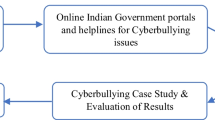Abstract
This paper presents a case study of phishing in Amsterdam, demonstrating that the current literature on criminal phishing networks provides an incomplete picture of this form of organized crime. The paper adds to the current literature by describing an organized group of phishers whose relationships are based on real-world social networks rather than internet forums, and who mainly use social engineering rather than malware as a tool to acquire information from their victims. Because the origin and growth of the Amsterdam network differ from those of groups previously described, other possibilities for situational crime prevention arise. In addition to technological measures, for example those aimed at forums, this article focuses on measures that target the social ties on which the networks are based.
Similar content being viewed by others
Notes
In this police investigation twenty money mules were interrogated and suspected to be part of the network. However, during the investigation many more were discovered. According to the respondents, during the criminal investigation period alone, at least 50–60 mules were used; however, it was simply too costly in terms of time to involve all of them in the investigation. The aim of the investigation was to identify and prosecute the core members of the group, not to prosecute all of the accomplices.
Using false identity papers, criminals are able to open new bank accounts (private or business), apply for internet bank accounts, or make changes to the account details of a client. The documents can also be used for other purposes. According to police respondents, they can be used, for example, for fraudulent telephone contracts and car rental. Whether the group actually did this is not known. The criminal investigation did not focus on the identity of the forger or on the specific activities that could be committed using false identities. However, it appears from the phone-tapped conversations that the group did purchase a number of fake identities from this facilitator.
Soudijn and Zegers (2012) described four stages: preparation, theft, transferring money and cash withdrawal. As the last two stages are so interconnected in our case, they are combined into one phase in this article.
References
Décary-Hetú D, Dupont B (2012) The social network of hackers. Glob Crime 13(3):160–175
Financial Fraud Action UK (2013) Decline in fraud losses stalled by rise in deception crime aimed at consumers. (News release 12 March 2013) <www.financialfraudaction.org.uk>.
Holt JT, Lampke E (2009) Exploring stolen data markets online: products and market forces. Crim Justice Stud 23(1):33–50
Kleemans ER, van der Berg AEIM, van de Bunt HG (1998) Georganiseerde criminaliteit in Nederland (Organized Crime in the Netherlands). WODC, Den Haag
Kleemans ER, Brienen MEI, van de Bunt HG, Kouwenberg RF, Paulides G, Barensen J (2002) Georganiseerde criminaliteit in Nederland, tweede rapportage op basis van de WODC-monitor (Organized crime in the Netherlands, second report based on the Monitor Organized Crime). WODC, Den Haag
Kleemans ER, de Poot CJ (2008) Criminal careers in organized crime and social opportunity structure. Eur J Criminol 5(1):69–98
Kleemans ER, van de Bunt HG (1999) The social embeddedness of organized crime. Transl Organized Crime 5(2):19–36
Kruisbergen, E.W., H.G. van de Bunt & E.R. Kleemans (2012) Georganiseerde criminaliteit in Nederland. Vierde rapportage op basis van de Monitor Georganiseerde Criminaliteit. (Organized crime in the Netherlands, fourth report based on the Monitor Organized Crime), Den Haag: Boom Lemma Uitgevers.
Lu Y, Luo X, Polgar M, Cao Y (2010) Social network analysis of a criminal hacker community. J Comput Inform Syst 51(2):31–41
NVB (Nederlandse Vereniging van Banken) (2013) Jaarverslag 2012. Een sector in dialoog. (Dutch Banking Association. Annual Report 2012). Nederlandse Vereniging van Banken, Amsterdam
Peretti KK (2008) Data breaches: What the underground world of ‘carding’ reveals. Santa Clara Comput High Technol Law J 25(2):345–414
Soudijn MRJ, Zegers BCHT (2012) Cybercrime and virtual offender convergence settings. Trends in Organized Crime 15(2–3):111–129
Soudijn MRJ, Monsma E (2012) Virtuele ontmoetingsuimtes voor cybercriminelen. Tijdschrift voor Criminologie (Virtual meeting places for cyber criminals) 54(4):349–360
Soudijn MRJ (2010) Wives, girlfriends and money laundering. J Money Laundering Control 13(4):405–416
van de Bunt HG, Kleemans ER (2007) Georganiseerde criminaliteit in Nederland, derde rapportage op basis van de Monitor Georganiseerde Criminaliteit (Organized crime in the Netherlands: third report based on the Monitor Organized Crime). WODC, Den Haag
Author information
Authors and Affiliations
Corresponding author
Rights and permissions
About this article
Cite this article
Leukfeldt, E.R. Cybercrime and social ties. Trends Organ Crim 17, 231–249 (2014). https://doi.org/10.1007/s12117-014-9229-5
Published:
Issue Date:
DOI: https://doi.org/10.1007/s12117-014-9229-5




